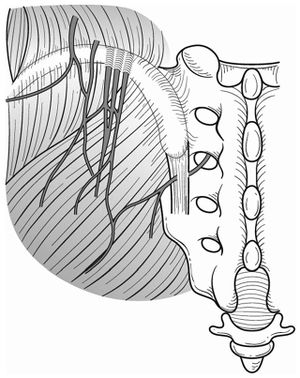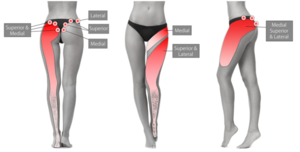Superior Cluneal Nerve Entrapment
| Superior Cluneal Nerve Entrapment | |
|---|---|
| Synonym | Cluneal nerve entrapment, cluneal neuralgia |
| Epidemiology | 14% of CLBP (SCN entrapment), MCN entrapment may be rare. |
| Pathophysiology | Repetitive friction of SCN under the thoracolumbar fascia, or rarely constriction in the osteofibrous tunnel. |
| Risk Factors | Thoracolumbar site fractures at the origin of the SCN |
| Diagnosis | SCN: tenderness over the site of the medial SCN branch, reproduction of symptoms with pressure, and pain reduction with local anaesthetic injection. |
| DDX | Sacroiliac joint pain, referred lumbar spine pain |
| Treatment | Repeated local anaesthetic injections, SCN or MCN decompression |
Some authors posit that cluneal nerve entrapment, also known as cluneal neuralgia, is an under-diagnosed cause of chronic low back and leg pain, and it can cause neuropathic type symptoms. Superior cluneal nerve entrapment is thought to be more common than middle cluneal nerve entrapment.
The best research paper on SCN entrapment that I have come across is a retrospective study by Kuniya et al who systematically evaluated 834 patients with CLBP; the article is open access and a highly recommended read. Their team has in general published a large amount of the recent literature on the topic.[1] A recent open access review article on SCN and MCN entrapment was authored by Isu et al[2]
Anatomy and Pathophysiology

The cutaneous nerve supply of the upper back is supplied by the medial branches of the upper thoracic dorsal rami. The lower back meanwhile is supplied by the lateral branches of the lower thoracic dorsal rami. Cluneal nerve irritation may arise due to entrapment in fascia or from nerve root irritation in the epidural space or foramen. In fascial entrapment there may be a self-perpetuating process.
- Superior cluneal nerve
The superior cluneal nerves are thought to be composed of T11-L4 dorsal rami lateral branches. Superior cluneal nerve (SCN) entrapment is thought to occur where the nerve pierces the thoracolumbar attachment at the posterior iliac crest as it becomes superficial. There are three branches of the SCN; the medial, intermediate, and lateral branches. Typically it has been described based on cadaver studies that the medial branch of the SCN passes through an osteofibrous tunnel and can be spontaneously entrapped there. There is significant anatomical variation. In a cadaver study of 109 medial branches, 39% passed through and osteofibrous tunnel, and of these only 5% exhibited obvious entrapment, or 2% of the total dissected branches.[4]
In the medial branch osteofibrous tunnel, the L4 and L5 lateral branches predominate. The most superior branch of the MCN often anastamoses with the medial SCN distally, and this may explain why leg symptoms are common as the MCN comprises of the sensory branches of the dorsal rami of S1-S3.
However, Kuniya et al found that in their 19 subjects requiring SCN release there were no cases of severe constriction within a bony groove on the iliac crest, but they found at least two SCN branches passing underneath a mixture of superficial thoracolumbar and gluteal fascia at the point of attachment to the iliac crest. They posited that true construction in the osteofibrous tunnel was rare, and that severe symptoms may be due to repetitive friction of the SCN under the fascia. In a further unpublished 26 cases, they had two cases of fascial constriction over the ilium.[1]
The prevalence of vertebral compression fractures is higher in those with SCN than in those without SCN disorder (26% vs 12%), most commonly at T12-L3. It is theorised that this causes a sagittal imbalance with increased kyphosis of the spine, thereby irritating the SCN at its origin from unstable facet joints or by stretching the SCN itself.[1] Maigne described thoracolumbar syndrome, whereby thoracolumbar dysfunction causes one of or a combination of unilateral iliac crest pain, lateral hip pain, and groin pain.
- Middle cluneal nerve
The middle cluneal nerve (MCN) arises from the S1-3 dorsal rami, and travels below the PSIS in an approximately horizontal route and supplies the skin overlying the posteromedial buttock. It can become trapped with passing underneath or through the long posterior sacroiliac ligament.[3]
Epidemiology
In one retrospective review of 834 patient with LBP, 14% were thought to be due to superior cluneal nerve entrapment. It is more common in middle age. Male and female distributions are roughly equal. See the diagnosis section below for their diagnostic method.[1]
Clinical Features

The cardinal symptom is chronic low back pain with or without leg symptoms. Pelvic malalignment may be present.
- SCN
In those with SCN disorder, around 50% have leg symptoms, but only 1% have leg symptoms only. The most commonly aggravating features are walking, rising from sitting, standing, flexion, and extension. Patients often find that pushing above the iliac crest with their hands relieves symptoms. Some patients have claudication like symptoms. The pain can persist for many years and some patients can be severely disabled.[1]
on examination coupling rotation to contralateral side and flexion can aggravate symptoms. As can flexion and contralateral rotation. Ipsilateral hip extension may reduce pain during flexion. The maximal tender points are described below.[1]
- MCN
MCN entrapment can be confused with sacroiliac joint pain. Even a positive sacroiliac joint block could still indicate LPSL pain or MCN entrapment if there is dorsal extravasation of the local anaesthetic. The S1 to S2 composition could explain why some patients may get leg symptoms. [3]
Diagnosis
- Superior cluneal nerve entrapment
There is no agreed diagnostic method. The diagnosis can be considered by tenderness over the iliac crest or LPSL causing provocation of symptoms. Pain relief following local anaesthetic injection can give further weight to the diagnosis.
Kuniya et al used the following diagnostic criteria [1]
- Maximal tenderness over the posterior iliac crest approximately 70 mm from the midline and 45 mm from the PSIS where the medial branch of the SCN runs through an osteofibrous tunnel consisting of the thoraco-lumbar fascia and the iliac crest (even if lesser tenderness exists elsewhere, for example at the thoracolumbar junction).
- Palpation of the maximally tender point reproduced the chief complaint of LBP and/or leg symptoms (Tinel-like sign)
- Temporary relief of symptoms by local anaesthetic injection
In their study, patients were included when they met the first two criteria. A nerve block injection was performed. If relief of symptoms is obtained following injection they suggest that this gives further weight to the diagnosis. In their study, if repeated injections failed to relieve symptoms then they had SCN decompression.
- Middle cluneal nerve entrapment
Again there is no agreed diagnostic method. The MCN tender point is typically on the LPSL within 40mm caudal to the PSIS.[3] Symptom relief by MCN block lends further weight to the diagnosis.
Treatment
Manual Therapy
Maigne would treat thoracolumbar syndrome with manipulation.
Injections
Trigger point injections have been described. In Kuniya et al's study, 47% required a second injection, and 25% required a third injection. In those who met the first two diagnostic criteria, 62% of patients had a 50% decrease of VAS after the first injection, 67% after the second injection, and 68% after the third injection.
There is very rare risk of erectile dysfunction following injections to the SCN.
An ultrasound guided injection technique is shown here
Radiofrequency neurotomy has also been described [5]
Surgery
Reports have been published on SCN release and MCN release. Most reports are on SCN release. In Kuniya's study, approximately 20% of patients proceeded to SCN decompression due to failure of having long term relief from repeated SCN nerve blocks. Predictors of success were pain duration less than 3 years, and consistently having relief for three days or more from SCN blocks.
References
- ↑ 1.0 1.1 1.2 1.3 1.4 1.5 1.6 Kuniya et al.. Prospective study of superior cluneal nerve disorder as a potential cause of low back pain and leg symptoms. Journal of orthopaedic surgery and research 2014. 9:139. PMID: 25551470. DOI. Full Text.
- ↑ Isu et al.. Superior and Middle Cluneal Nerve Entrapment as a Cause of Low Back Pain. Neurospine 2018. 15:25-32. PMID: 29656623. DOI. Full Text.
- ↑ 3.0 3.1 3.2 3.3 Aota. Entrapment of middle cluneal nerves as an unknown cause of low back pain. World journal of orthopedics 2016. 7:167-70. PMID: 27004164. DOI. Full Text.
- ↑ Kuniya et al.. Anatomical study of superior cluneal nerve entrapment. Journal of neurosurgery. Spine 2013. 19:76-80. PMID: 23641672. DOI.
- ↑ 5.0 5.1 Martin Knight., et al. “A Radiofrequency Treatment Pathway for Cluneal Nerve Disorders”. EC Orthopaedics 11.3 (2020): 01-19 Full Text
Literature Review
- Reviews from the last 7 years: review articles, free review articles, systematic reviews, meta-analyses, NCBI Bookshelf
- Articles from all years: PubMed search, Google Scholar search.
- TRIP Database: clinical publications about evidence-based medicine.
- Other Wikis: Radiopaedia, Wikipedia Search, Wikipedia I Feel Lucky, Orthobullets,


